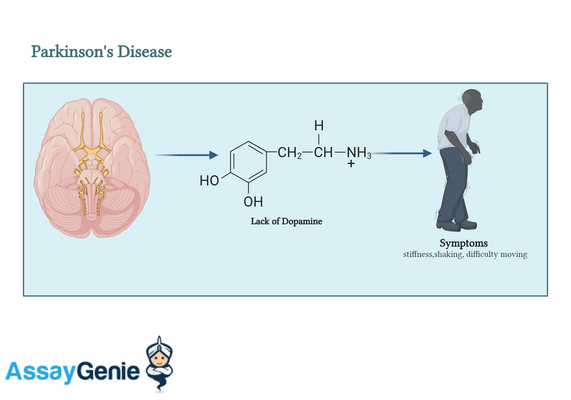Decoding Parkinson's Disease: Insights into a Complex Neurological Disorder
Parkinson's disease (PD) is a progressive neurological disorder that primarily affects the motor system, leading to a wide array of symptoms ranging from tremors and stiffness to bradykinesia (slowness of movement) and postural instability. Beyond these hallmark motor symptoms, Parkinson's disease can manifest in non-motor symptoms such as cognitive decline, mood disorders, and autonomic dysfunction, making it a multifaceted condition that challenges both individuals and healthcare systems worldwide. This article delves into the etiology, pathophysiology, clinical manifestations, and therapeutic strategies for Parkinson's disease, shedding light on the complexities of this debilitating disorder and the ongoing efforts to find more effective treatments.
Understanding the Etiology and Pathophysiology:
Parkinson's disease is characterized by the degeneration of dopaminergic neurons in the substantia nigra pars compacta, a critical area of the brain involved in regulating movements. The loss of these neurons leads to a decrease in dopamine, a neurotransmitter essential for smooth, purposeful movement. Additionally, the presence of Lewy bodies, abnormal aggregates of the protein alpha-synuclein, within the surviving neurons is a hallmark pathological feature of PD.
The precise cause of neuronal degeneration in Parkinson's disease remains largely elusive, with research pointing towards a combination of genetic and environmental factors. Genetic mutations in several genes, including SNCA (alpha-synuclein), LRRK2, PARK7, PINK1, and PRKN, have been identified in familial cases of PD, suggesting a genetic predisposition in a subset of patients. Environmental factors, such as exposure to pesticides and heavy metals, have also been implicated in increasing the risk of developing PD, highlighting the disease's multifactorial nature.
Clinical Manifestations: Beyond Motor Symptoms
While tremors, rigidity, bradykinesia, and postural instability constitute the core motor symptoms of Parkinson's disease, the condition's impact extends far beyond motor control. Non-motor symptoms, often preceding motor symptoms, significantly affect the quality of life and may include:
- Cognitive Impairment and Dementia: Progressive cognitive decline, leading to Parkinson's disease dementia in advanced stages.
- Mood Disorders: Depression and anxiety are common, affecting patients' emotional well-being.
- Autonomic Dysfunction: Manifesting as orthostatic hypotension, constipation, and urinary incontinence.
- Sleep Disturbances: Including REM sleep behavior disorder and insomnia.
Therapeutic Strategies and Management:
Currently, there is no cure for Parkinson's disease, and treatment focuses on managing symptoms to improve quality of life. Levodopa, a precursor to dopamine, remains the gold standard in symptomatic treatment, effectively alleviating motor symptoms by increasing dopamine levels in the brain. However, long-term use of levodopa can lead to complications, such as motor fluctuations and dyskinesias (involuntary movements).
Advances in therapeutic approaches have led to the development of dopamine agonists, monoamine oxidase B (MAO-B) inhibitors, and deep brain stimulation (DBS) as alternative or adjunctive treatments to manage symptoms and reduce levodopa-related complications. Additionally, non-pharmacological interventions, including physical therapy, occupational therapy, and speech therapy, play a crucial role in managing the disease.
The Frontier of Parkinson's Disease Research:
Research into Parkinson's disease is actively pursuing multiple fronts, from unraveling the genetic underpinnings and environmental triggers to developing disease-modifying therapies. Novel therapeutic targets, such as alpha-synuclein, are being explored to slow or halt disease progression. Immunotherapy targeting alpha-synuclein aggregates and gene therapy aimed at restoring dopamine production or mitigating genetic risk factors are among the promising avenues of research.
Furthermore, the potential of stem cell therapy to replace lost dopaminergic neurons offers hope for a breakthrough in Parkinson's disease treatment. Clinical trials investigating the safety and efficacy of various stem cell types, including induced pluripotent stem cells (iPSCs), are underway, marking significant strides towards regenerative therapies for PD.
Conclusion
References
- Obeso, J.A., Stamelou, M., Goetz, C.G., Poewe, W., Lang, A.E., Weintraub, D., Burn, D., Halliday, G.M., Bezard, E., Przedborski, S., Lehericy, S., Brooks, D.J., Rothwell, J.C., Hallett, M., DeLong, M.R., Marras, C., Tanner, C.M., Ross, G.W., Langston, J.W., Klein, C., Bonifati, V., Jankovic, J. (2017). Past, present, and future of Parkinson's disease: A special essay on the 200th Anniversary of the Shaking Palsy. Movement Disorders, 32(9), 1264-1310.
- Schapira, A.H.V., Chaudhuri, K.R., Jenner, P. (2017). Non-motor features of Parkinson disease. Nature Reviews Neuroscience, 18(8), 509.
- Polymeropoulos, M.H., Lavedan, C., Leroy, E., Ide, S.E., Dehejia, A., Dutra, A., Pike, B., Root, H., Rubenstein, J., Boyer, R., Stenroos, E.S., Chandrasekharappa, S., Athanassiadou, A., Papapetropoulos, T., Johnson, W.G., Lazzarini, A.M., Duvoisin, R.C., Di Iorio, G., Golbe, L.I., Nussbaum, R.L. (1997). Mutation in the alpha-synuclein gene identified in families with Parkinson's disease. Science, 276(5321), 2045-2047.
- Dehay, B., Bourdenx, M., Gorry, P., Przedborski, S., Vila, M., Hunot, S., Singleton, A., Olanow, C.W., Merchant, K.M., Bezard, E., Petsko, G.A., Meissner, W.G. (2015). Targeting α-synuclein for treatment of Parkinson's disease: mechanistic and therapeutic considerations. The Lancet Neurology, 14(8), 855-866.
- Lang, A.E., Lozano, A.M. (1998). Parkinson's Disease. First of two parts. The New England Journal of Medicine, 339(15), 1044-1053.
- Olanow, C.W., Stern, M.B., Sethi, K. (2009). The scientific and clinical basis for the treatment of Parkinson disease. Neurology, 72(21 Suppl 4), S1-136.
- Kordower, J.H., Olanow, C.W., Dodiya, H.B., Chu, Y., Beach, T.G., Adler, C.H., Halliday, G.M., Bartus, R.T. (2013). Disease duration and the integrity of the nigrostriatal system in Parkinson's disease. Brain, 136(Pt 8), 2419-2431.
- Björklund, A., Dunnett, S.B. (2007). Dopamine neuron systems in the brain: an update. Trends in Neurosciences, 30(5), 194-202.
Written by Tehreem Ali
Tehreem Ali completed her MS in Bioinformatics and conducted her research work at the IOMM lab at GCUF, Pakistan.
Recent Posts
-
Metabolic Exhaustion: How Mitochondrial Dysfunction Sabotages CAR-T Cell Therapy in Solid Tumors
Imagine engineering a patient's own immune cells into precision-guided missiles against cancer—cells …8th Dec 2025 -
The Powerhouse of Immunity: How Mitochondrial Fitness Fuels the Fight Against Cancer
Why do powerful cancer immunotherapies work wonders for some patients but fail for others? The answe …5th Dec 2025 -
How Cancer Cells Hijack Immune Defenses Through Mitochondrial Transfer
Imagine a battlefield where the enemy doesn't just hide from soldiers—it actively sabotages their we …5th Dec 2025




